A Field of Dreams for Vision Research
By Jason Socrates
Bardi
"But
from thine eyes my knowledge I derive,
And, constant stars, in them I read such art."
——William
Shakespeare, from Sonnet XIV, circa 1594
"If you build it, they will come," was the oft-repeated
line from the 1989 film Field of Dreams, which told
the story of a farmer who had a vision to build a baseball
diamond in the middle of his cornfield.
No single line more accurately describes the work of a handful
of researchers at The Scripps Research Institute (TSRI) who
for the last several years have been building their own diamond
dream—collaborations and multidisciplinary research projects
that aim to make an impact in the field of vision research
and to touch lives by finding an approach to treating ocular
diseases.
And now this work is beginning to attract attention. The
National Eye Institute (NEI) and the rest of the vision research
world is beginning to recognize TSRI, with its team of interdisciplinary
researchers, as a major center for vision and eye research—research
that is critically important, since vision loss does and will
continue to affect the quality-of-life in our aging society.
"Virtually every American has one of the diseases or knows
somebody who has one of the diseases that could be effectively
treated if we develop a drug to prevent abnormal growth and
function in the eye," says Martin Friedlander, associate professor
in the Department of Cell Biology and chief of the Retina
Service in the Division of Ophthalmology, Department of Surgery
at Scripps Clinic.
Building Upon Past Successes
The latest recognition of the vision research at TSRI is
a $9.6 million NEI grant, which was recently awarded to Friedlander
and several other investigators at TSRI to take basic science
observation as close to the clinic as possible.
The grant, titled Fragments of TrpRS to Treat Neovascular
Eye Disease, also includes TSRI investigators Paul Schimmel,
who is Ernest and Jean Hahn Professor of Molecular Biology
and Chemistry and a member of the Skaggs Institute for Chemical
Biology; Dale L. Boger, Richard and Alice Cramer Professor
of Chemistry; Professor David Cheresh and Associate Professor
Glen Nemerow, both of TSRI's Department of Immunology; and
Gary Siuzdak, Adjunct Associate Professor of the Department
of Molecular Biology.
For Friedlander, the grant is testament to the fact that
TSRI is the perfect place for such a project, since it combines
first-rate basic vision science with the nearby clinical resources
of the Scripps Clinic. The program, which is already up and
running, was favorably reviewed and funded by the NEI, and
in part, this was because of the existing collaborations of
the grant's investigators and the high potential this work
has to translate bench work to the bedside.
For instance, Friedlander and Nemerow already participate
in the NEI-funded Core Center for Vision Research at TSRI,
which began operations last summer, providing shared support
resources for 11 TSRI researchers and six researchers from
the University of California, San Diego (UCSD) who have independent
programs in vision science funded through the NEI.
The Core Grant for Vision Research supports several core
facilities to provide additional resources for the independent
programs of these researchers and others doing vision science
research. A microarray core module produces DNA "chip" microarrays
that can be used for observing changes in gene expression
during the course of normal and pathological changes in the
eye. Similarly, a proteomics core module provides global analysis
of all the proteins expressed. A microscopy and imaging core
module allows the phenotypic state of eye tissue to be studied
in conjunction with the expression data that comes from the
microarray and proteomics cores, taking advantage of a new
state-of-the-art multiphoton scanning laser confocal microscope.
In May, a $500,000 supplement for technology enhancement
was awarded to Friedlander for one of his grants from the
National Eye Institute. These funds were used to purchase
a new Maldi-TOF spectrometer and additional imaging equipment
to further expand resources available to TSRI and UCSD vision
researchers already working together through the Core Grant
for Vision Research.
"We are very excited about this [new] interdisciplinary
project to study a very exciting new anti-angiogenic and delivery
systems that will enable us to bring it to sites of abnormal
ocular angiogenesis," says Friedlander. "We are particularly
grateful to the NEI for providing the resources to establish
this program."
Angiogenesis and Vision Loss
The vast majority of diseases that cause catastrophic vision
loss do so as a result of abnormal vessel growth in the back
of the eye. In fact, the leading cause of vision loss in patients
who are above the age of 65 is macular degeneration.
"Twelve to fifteen million people in this country alone
have macular degeneration," says Friedlander. "And 10 to 15
percent of them will suffer acute loss of central, or 'reading,'
vision."
In patients under the age of 65, the leading cause of vision
loss is due to a complication of diabetes known as diabetic
retinopathy. Some 16 to 18 percent of the U.S. population
has diabetes. Virtually every one of those patients will eventually
have a form of diabetic retinopathy after 20 years, says Friedlander,
and every year 40,000 of them lose vision.
Both macular degeneration and diabetic retinopathy are characterized
by angiogenesis, or the development of abnormal blood vessel
growth in the eye. In the case of macular degeneration, new
blood vessels grow under the retina. In diabetic retinopathy,
abnormal vessels grow on top of the retina. The effect is
much the same; the vessels interfere with normal structures
or the transmission of light to the back of the eye, impeding
vision.
There is currently no effective treatment for the vast majority
of these patients. For several years, researchers have sought
compounds that inhibit angiogenesis and curtail the diseases.
There are several anti-angiogenic compounds in clinical
trials. But one of the more promising, says Friedlander, is
TrpRS, the one the TSRI researchers will be developing with
the NEI funding.
"People typically talk about 20, 30, 40 percent inhibition
[of new vessel formation] for the compounds that are in clinical
trials," says Friedlander. "What we have seen in our pre-clinical
studies is that in 70 percent of cases, you get 100 percent
inhibition."
"Our hope is that TrpRS may be something we someday use
to treat patients with neovascular eye disease."
TrpRS and the Autoregulation of Angiogenesis
The original work started with Schimmel, who had been studying
RNA synthetases for a number of years.
After a gene is transcribed from double-stranded DNA into
a single-stranded form of RNA called messenger RNA (mRNA),
a large molecule called the ribosome translates the mRNA into
a protein. The ribosome recognizes another type of molecule,
transfer RNA (tRNA), which brings the ribosome the amino acids
from which it constructs proteins.
One of the first steps of protein synthesis involves "charging"
the tRNA molecules with the amino acids, and this step is
carried out by a set of molecules known as tRNA synthetases.
TrpRS, for instance, charges tRNA molecules with the amino
acid tryptophan. Since protein synthesis provides the raw
material during angiogenesis, tRNA synthetases play a big
role. And, indeed, several years ago, Schimmel showed that
a full length tyrosine tRNA synthetase served as a pro-angiogenic
molecule.
Noticing that another similar enzyme, the tryptophanyl tRNA
synthetase "TrpRS", had similar motifs as the tyrosine enzyme,
Schimmel and his laboratory reasoned that like the tyrosine
tRNA synthetase, the TrpRS would promote angiogenesis. Much
to his amazement, however, TrpRS not only was not a promoter
of angiogenesis—it actually inhibited the process.
This was a surprising result, since one would not expect
a molecule involved in protein synthesis and cell proliferation
to be involved in shutting down that same proliferation.
"Then," says Schimmel, "a talented postdoctoral student
in our laboratory—Kei Wakasugi—had the original
idea that a fragment of human TrpRS could be active in angiogenic
pathways."
Interestingly, two naturally occurring, shortened forms
of the molecule proved to be even more powerful inhibitors
of angiogenesis. These truncated forms are either made after
one end of the full-size TrpRS is chopped off by proteolysis
or they are synthesized from an "alternatively spliced" mRNA,
which has been rearranged by the cell before the ribosome
uses it to make a protein.
Wakasugi and others in the laboratory did many tests and
established that the TrpRS fragments were, indeed, inhibitors
of angiogenesis in cell culture. But Schimmel and his laboratory
wanted to test the TrpRS fragments using more powerful models,
such as those that Friedlander had already developed over
the course of studying angiogenesis for several years. In
this model system normal vessel formation in the eye resembles,
in many ways, the type of angiogenesis observed in human neovascular
eye disease.
"We were then fortunate to have wonderful collaborators
here at The Scripps—the laboratories of Marty Friedlander
and David Cheresh—who gave us the opportunity to then
extend the work by testing two of the fragments in animal
models that they had specifically developed for angiogenesis,"
says Schimmel.
In the subsequent experiments, they confirmed the earlier
findings and extended them by demonstrating the TrpRS fragments
were potent anti-angiogenics.
The fact that TrpRS is a naturally occurring protein may
make it an even more effective treatment because it will not
have the same problems of toxicity and immunogenicity that
plague some other potential drugs.
"Moreover," says Friedlander, "this is something that we
can teach the cell how to make." One clinical approach to
treating angiogenic vision loss, he says, could be to deliver
the TrpRS molecules directly into the eye through gene- and
cell-based vectors.
1 | 2 |

|
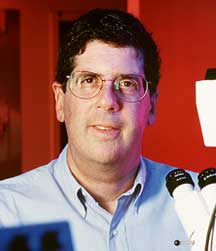
Associate Professor Martin Friedlander
is lead investigator for the $9.6 million National Eye Institute
grant.
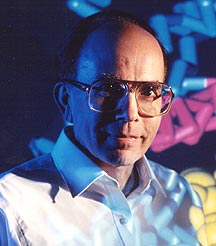
TSRI investigator Paul Schimmel (above)
gives credit to "a talented postdoctoral student," Kei Wakasugi,
for coming up with the idea that a fragment of human TrpRS
could be active in angiogenic pathways.
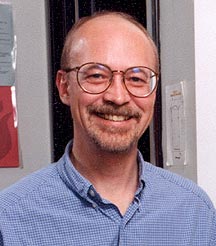
Investigator Dale L. Boger says, "It
is only through the coordinated efforts of several superb
groups that a problem of such a magnitude could be attempted."
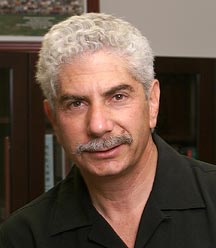
Professor David Cheresh has been working
on a delivery system that selectively targets the cells that
form new blood vessels in angiogenesis without influencing
the normal blood vessels or any other tissue.
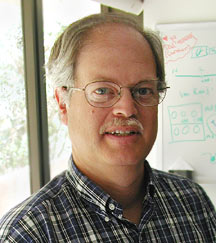
Investigator Glen Nemerow has been researching
a separate approach that involves using adenovirus vectors
as delivery vehicles.
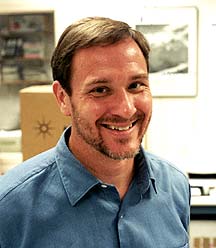
"This effort represents one of the true
strengths of TSRI, in that individuals from very different
areas of research can combine their expertise to tackle scientifically
fundamental, yet medically important, problems," says investigator
Gary Siuzdak.
|

